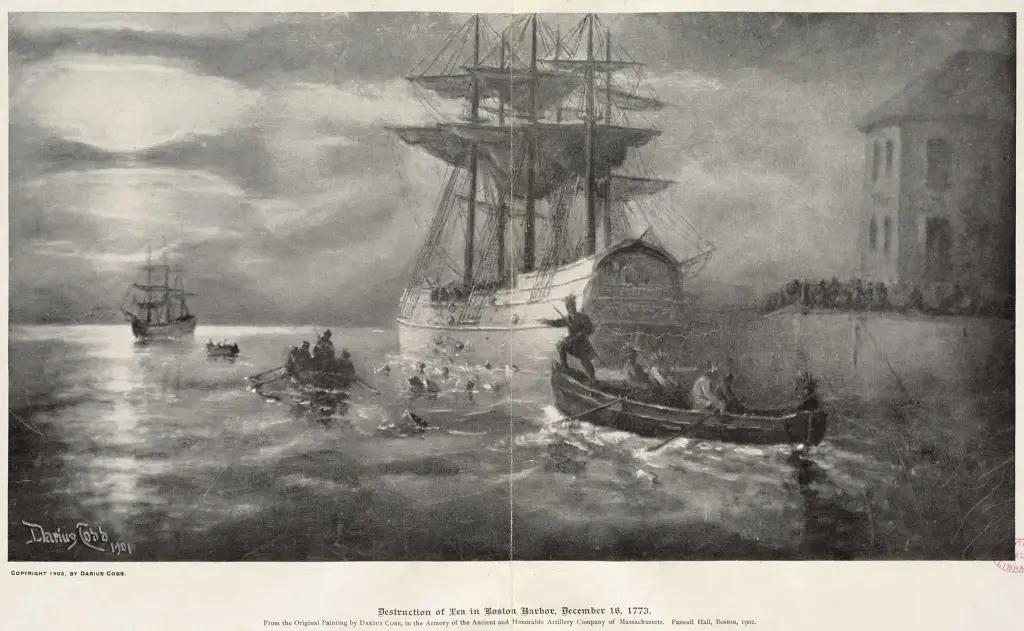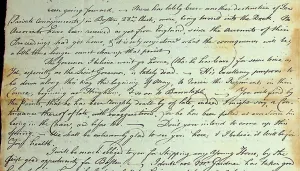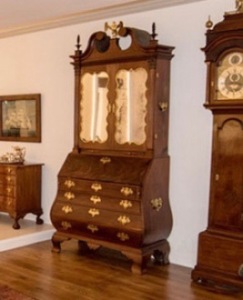A headline in the Patriot-Ledger a year ago caught my eye: “Boston Tea Party participants honored at Cohasset Cemetery.” The story described ceremonies at two Cohasset cemeteries to recognize young patriots involved in the famous December 1773 act of protest. It got me thinking: Might some Hingham men have been among those who dumped the tea on that day? As this year’s anniversary of the Boston Tea Party approaches, I decided to find out more.

Destruction of the Tea in Boston Harbor, December 16, 1773. Engraving from a Painting by Darius Cobb. Boston Public Library.
As described by Walter L. Bouve in the 1893 History of Hingham:
At three o’clock in the afternoon of December 16, 1773, young Josiah Quincy finished his great speech [to the Boston Town Meeting, at] the Old South Meeting-house, and the people reaffirmed the vote of November 29, that the tea in the ships in Boston harbor should not be landed. Towards twilight…a war whoop rang from the gallery of the Old South; it was taken up from the outside. The meeting adjourned…and the populace flocked towards Griffin’s wharf…Here were moored the “Dartmouth,” (Captain Hall); the “Eleanor,” (Captain Bruce,) and the “Beaver,” (Captain Coffin). Led by some twenty persons disguised as Mohawk Indians, a party numbering some hundred and forty boarded the vessels, and in two hours three hundred and forty-two chests of tea were emptied into the harbor.
An artifact at the Hingham Historical Society’s Old Ordinary museum may include a memento of the event. An antique tea caddy, donated to the Society by Mary Henrietta Gibson Hersey, the widow of Alfred Henry Hersey, shortly before her death in 1941, came with a small quantity of loose tea and a note capturing the history of the tea — as provided to the family by an Elizabeth Hersey (unclear which, of a number of Elizabeth’s in the family, this would have been): “Tea from one of the vessels whose cargo was thrown overboard in Boston harbor by the Patriots at the beginning of the Revolution, December 16, 1773.”

Loose tea from Hersey family tea caddy at the Old Ordinary
Alfred H. Hersey’s great grandfather, Thomas Hersey, was a patriot during the American Revolution. Alfred was also known to be a collector of historic items. But it is unknown how long this tea may have been in the care of the Hersey family. Recently, Ellen Miller, who knew of the note and the tea from the many hours she spends at the Old Ordinary as a docent and as a trainer of volunteers for the house museum, told me she had asked a museum docent at the Boston Tea Party Ships and Museum if loose tea from the event may have been saved as souvenirs. Ellen was told that, because the tide was out at that time of day on the sisteenth of December in 1773, the dumping of the tea would have created quite a mess on and near Griffin’s Wharf, and participants likely left the site with loose tea in cuffs and pockets. The Massachusetts Gazette of December 23, 1773 reported that “When the tide rose it floated the broken chests and the tea insomuch that the surface of the water was filled therewith a considerable way from the south part of the town to Dorchester Neck, and lodged on the shores.” The Massachusetts Historical Society has in its collection a glass bottle full of tea leaves that were collected on the shore of Dorchester Neck on the morning of December 17, 1773. So perhaps the tea in the caddy at the Old Ordinary is indeed from the famous Boston Tea Party.
I found it interesting to learn that there was at least one additional protest involving dumping tea into Boston Harbor. As described on history.com, the website of The History Channel: “Three months after the Boston Tea Party, Bostonians once again sent tea splashing when 60 disguised men boarded the Fortune, in March 1774, forced the crew below deck and dumped tea chests into the harbor. The sequel wasn’t quite as impressive as the original, however, as only 30 chests were sent overboard.”
 This March 1774 event was referenced in a letter sent by loyalist Jotham Gay to (British) Colonel Joshua Winslow. The original of the full letter, which Michael Achille kindly scanned for me to read, is in the archives at the Hingham Heritage Museum. On March 23, 1774, Jotham wrote to the Colonel: “…There has lately been another destruction of tea–private consignments–in Boston, about 28 chests more being thrown into the dock. No accounts have been received as yet from England, … and it is only conjecture what the consequences will be….”
This March 1774 event was referenced in a letter sent by loyalist Jotham Gay to (British) Colonel Joshua Winslow. The original of the full letter, which Michael Achille kindly scanned for me to read, is in the archives at the Hingham Heritage Museum. On March 23, 1774, Jotham wrote to the Colonel: “…There has lately been another destruction of tea–private consignments–in Boston, about 28 chests more being thrown into the dock. No accounts have been received as yet from England, … and it is only conjecture what the consequences will be….”
Jotham Gay, a son of Reverend Ebenezer Gay, minister of Old Ship Church for 69 years, was born in Hingham in April of 1733 and would be a Captain “in the King’s service from 1755 until near the close of the last French war.” (Among Gay’s company fighting in Canada in 1759, as part of the British forces during what we know as the Seven Years War, were Hingham men recruited from the local militia including: George Lane, Lieutenant; Noah Humphrey, Caleb Leavitt, Israel Lincoln, Charles Ripley, Luther Stephenson, John Sprague, Daniel Stoddard, Daniel Tower, and Seth Wilder.)
Jotham’s loyalist inclinations during the Revolutionary War (his brother Martin was also a loyalist) led the brothers to live for a time in Canada. Their loyalist father, Reverend Ebenezer Gay, stayed in Hingham, serving the Old Ship congregation, then a mix of loyalist and patriot sentiment. Both Jotham and Martin returned to Hingham after the Revolution where Jotham died in 1802 and Martin died in 1809.

The “Old Tory” in the Kelly Gallery at the Hingham Heritage Museum
The beautiful drop-front desk and bookcase shown here–built for Martin Gay and his wife Ruth as a wedding gift (by the bride’s brother Gibbs Atkins) and on display in the Kelly Gallery of the Hingham Heritage Museum)–is called the “Old Tory” in recognition of Martin’s political leanings. The desk traveled to Nova Scotia when Martin left Hingham as part of the British evacuation of Boston in 1776, traveled with him to England in 1788, and then back to Boston in 1792. The desk descended in the Gay family until Ebenezer and Diana Gay donated it to the Hingham Historical Society in 2014.
In addition to the Boston Tea Party and additional tea dumping in March of 1774, similar protest involving tea dumping would occur in East Coast colonial port cities throughout 1774.
Now, back to my original question: Were any men from Hingham involved in the Boston Tea Party on December 16, 1773?
YES! While the protestors kept their identities secret for many years after the event, knowledge of many, though not all, participants has emerged over time. (The graves of about 85 known participants in the Boston Tea Party have been identified in Massachusetts.) At this point we can fairly confidently name six men born in Hingham who participated. Four of them had been identified when Walter L. Bouve wrote his section on military history for the multi-volume, richly detailed 1893 History of Hingham. The remaining two names have surfaced as the work of the Boston Tea Party museum, the Daughters of the American Revolution, and local historians continues to fill out the story of events related to the Revolution. The family names of all six will sound familiar to those who follow Hingham’s history: Beal, Joy, Lincoln, Sprague, Stoddard, and Tower. They were all young men when they joined others in dumping British tea into Boston Harbor. Later each of them helped fight the British during the Revolutionary War.

Jared Joy Gravestone at Beechwood Cemetery, Cohasset, MA
The three men whose graves in Cohasset were being decorated as covered by the Patriot Ledger in 2019 are among these six sons of Hingham, though Cohasset can rightly claim them as well. Jared Joy, James Stoddard II and Abraham Tower are buried in Cohasset–two of them at the Cohasset Central Cemetery, and one (Jared Joy) at Beechwood Cemetery. They all grew up in what was, at the time of their births, the Second Precinct of Hingham. In 1770, this area became part of the new town of Cohasset, and so at the time of the Boston Tea Party in 1773, Jared, Samuel, and Abraham had become residents of Cohasset.
Here is more about their Hingham family backgrounds:
• JARED JOY: Age 24 on the day of the Boston Tea Party. Jared was born in Hingham on December 19, 1749. His father was Amos Joy (born in Hingham in 1720, died in Cohasset in 1813). His mother was Patience Bates (born in Hingham in 1723, died in Cohasset in 1818). Jared’s family lived on Beechwood Street, originally part of the Second Precinct of Hingham, which later (in 1770) became part of the new town of Cohasset. Amos Joy, Jared’s father, was deacon of the Church—known as Second Parish when established in 1721, at a time when the area was still a part of Hingham.
Jared was a direct descendant of Thomas Joy, who arrived in Hingham (from Boston) in about 1646 “to erect or to enlarge a grist mill at the town cove, and also to establish a saw-mill in the same locality, perhaps adjoining the former” according to the 1893 History of Hingham (which references Solomon Lincoln’s earlier History of Hingham, as well as land deeds for what was then Suffolk County).
Jared Joy served in the Revolutionary War in a company primarily made up of men from the Second Precinct, as part of the 25th regiment of the Continental Army commanded by General William Heath, according to the 1893 History of Hingham. I have not yet discovered Jared’s field of work following the Revolution. He died young, at age 43, in 1792, when the republic he had fought for was in its infancy. Jared’s headstone at Cohasset’s Beechwood cemetery is shown above.
• JAMES STODDARD II: Age 17 on the day of the Boston Tea Party. James was born September 24, 1756 in Hingham. Parents were James Stoddard Sr. (born in Hingham in 1733) and Susannah Humphrey (born in Hingham in 1736). James Stoddard Sr. and his wife Susanna would both die in Winchendon, Massachusetts – he in 1816 and his wife in 1818. When James was young though, they lived in the Second Precinct, in the part of town that became the new town of Cohasset in 1770 (when James would have been 14). James was the first of 11 children.
The family known over generations variously as Stodder or Stoddard, with some spelling variations, began with John “the planter” who had a land grant in Hingham in 1638. While I have not seen records of what John grew, he had many fields. When he died his estate included “land at Weymouth River, in Hockley field next to Moses Colyers, in the Plaine Neck, on the Great Playne at Conahasset, and in the Wayre Neck.”
At the time of the Boston Tea Party, according to the 2019 Patriot Ledger article, the teenaged James Stoddard II was an apprentice in a grist mill in Boston. According to an account written in a DAR publication in 1901, “He served in the militia during the siege of Boston and was stationed at Hull from December 12, 1775 to April 8, 1776. About this time an English brig bound for Boston with supplies for the British army was becalmed off Cohasset and captured by a boat’s crew of Cohasset men led by James Stoddard. James Stoddard afterward served about three years in Knox’s artillery regiment.” He is identified in the 1893 History of Hingham as a shipwright (perhaps an occupation that followed his youthful apprenticeship at a mill in Boston). James Stoddard died on March 11, 1833 at age 76.
• ABRAHAM TOWER: Age 21 on the day of the Boston Tea Party. Abraham was born April 18, 1752. Son of Daniel Tower and Bethia Nichols Tower, who both were born in Hingham. Abraham’s family resided in the Second Precinct, which became part of new town of Cohasset in 1770, when Abraham was 18. He was one of 14 children of Daniel and Bethia, some of whom died in infancy.
Abraham was a direct descendant of John Tower, identified as “Farmer” or “Planter,” born in Hingham, England, who became a resident of Hingham in the Massachusetts colony in 1637. Upon his arrival he had a grant of three acres of land for a house lot on Bachelor (Main) Street, nearly opposite what is now Water Street. Other land grants he acquired over time included what became the family home for generations, on Main Street near “Tower Bridge.”
Abraham Tower fought in the Revolutionary War as a soldier in Captain Job Cushing’s company. He married Elizabeth Kent in 1789; and after she died, married her sister Hannah Kent (in Oct 1800.) Abraham was a master shipbuilder, farmer, and fisherman. According to a 1901 publication of the Daughters of the American Revolution: “Tradition says that [Abraham’s] sister Persis sailed a vessel across the bay to Gloucester to get supplies when Boston Harbor was filled with British vessels. Abraham served as a corporal in Captain Job Cushing’s company at the siege of Boston. This is the same company in which his “Second Precinct” neighbors Jared Joy, and, for a time, James Stoddard served as privates, based on a listing in the 1893 History of Hingham. Abraham later achieved the rank of sergeant. Abraham died on September 26, 1832.
There were three other sons of Hingham involved in the Boston Tea Party. PART TWO of this blog will cover more of the story…
Nature vs. Nurture: Consider the Spragues, Part 3
In this final part of my blog about the Sprague family, I’ll highlight descendants of Ralph Sprague, the oldest of the three brothers who came to the Massachusetts Bay Colony in 1628. In the books written about Ralph Sprague and his family, Ralph is most highly regarded for his service to the Massachusetts Bay Colony.…
Nature vs. Nurture: Consider the Spragues, Part 2
William Sprague’s line of the family achieved prominence in the arts—from botanical illustration to poetry. In this “Rev 250” period of commemoration of the War for Independence, I need to first mention that William’s great-great grandson, Samuel Sprague, born in Hingham in 1753, was a Revolutionary War Patriot who also participated in the Boston Tea…
Nature vs. Nurture: Consider the Spragues
While doing research for the Hingham Historical Society’s 2023-24 lecture series, Suburbia: The American Dream, I learned of the important contribution of late 19th/early 20th century electrical engineer and inventor Frank Julian Sprague to the electric streetcar—an engine critical to early suburban development in the U.S. The name Sprague caught my attention. In his landmark…